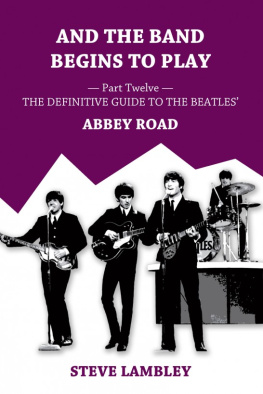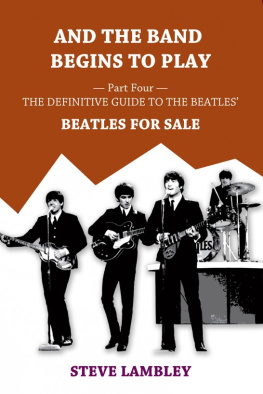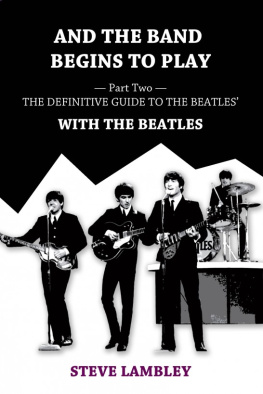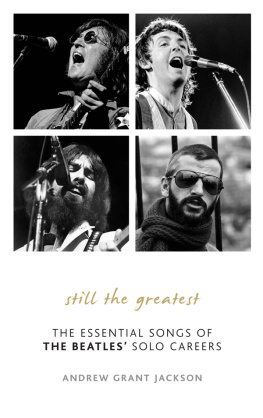All the Songs
THE STORY BEHIND EVERY BEATLES RELEASE
JEAN-MICHEL GUESDON
&
PHILIPPE MARGOTIN
PREFACE BY Patti Smith
Scott Freiman, CONSULTING EDITOR

TABLE OF CONTENTS
PREFACE
On the eve of June 1, 1967, my friend Janet Hamill and I were camped in the family laundry room with a transistor radio, feverishly awaiting midnight. At that moment the Beatles new album, Sgt. Peppers Lonely Hearts Club Band, was to be premiered across America over local FM radio stations. It was a unifying moment for our generation, and joining the collective mind, we listened transfixed. The moods swung madly from cut to cutRingos inclusive With A Little Help from My Friends, Pauls look into the future with When Im 64, Georges trance-like Within You Without You, the calliope of Johns Mr. Kite. By the time A Day In The Life unfolded and the final chord stretched out into forever, we were ecstatic. For two aspiring young poets, that midnight journey offered possibilities that spun off in all directions.
I had come late to the Beatles. In the great divide of the new groups from England, I preferred the darker, more visceral Animals and Rolling Stones. But as the Beatles grew musically and conceptually, I was drawn in. By Rubber Soul I felt myself along for their ride, and with Revolver I was sold, acknowledging their influence and their enduring effect on our cultural voice.
I joined the legions seduced by the words of their worldall four worlds, that is. The mystic paths lit by the lantern of George. The human and melancholic joy of Ringo. The cinematic visions of Paul. Johns heightened, Joycean wordplay. They were so different from one another, like the four points on a compass, and yet contributed so much as a band. They combined the spiritual and the romantic, the absurd and political, and as they evolved, we evolved with them.
They aspired to literacy, which makes this book all the more revelatory. Even their earliest work, She Loves You or I Want To Hold Your Hand, has the simplicity of a Hank Williams song, poetry reduced to its essential phrase. By the time they reach the emotionally surreal landscape of Strawberry Fields Forever, which heralded the coming of Sgt. Pepper in that sacred spring, their abstract imagery had become dreamlike, hallucinatory. Somehow it all made sense.
Their songs got into your head, heard from passing cars, storefronts and jukeboxes. We sang along wholeheartedly. We sang lyrics knowing and yet not knowing their multi-leveled meanings. These songs offered a sometimes-undecipherable and poetic language made familiar with melodies and harmonies that fit hand-in-glove. We did not need to break them down. We felt them. They embraced the small in the humble and exquisite Blackbird and expanded humankind with the universal phrase All you need is love. In between lies an arc only few are gifted-to embody the generational shift from adolescence into maturity. To grow and serve within ones words, ones music, ones art.
Patti Smith
FOREWORD
Between June 6, 1962, the date of the first audition of the Beatles at Abbey Road Studios, and May 8, 1970, the date of the release of their last album, John Lennon, Paul McCartney, George Harrison, and Ringo Starr wrote an exceptional page in the history of popular music and changed the musical panorama of the sixties. However, the four young men from Liverpool, the future Fab Four, could not have predicted anything so phenomenal in their early days. No one could imagine that a group of guitarists (three guitarists and a drummer) would become a strong influence on their contemporaries and future generations. When they landed on the tarmac at JFK Airport in 1964, Elvis did not even feel threatened.
How could have we guessed that the Beatles would open the doors to the New World to other British music groups such as the Stones, the Kinks, and the Who, and would attain such worldwide popularity?
Those who love and are interested in the Beatles are probably wondering why we would dedicate another book to the group. However, today, fifty years after the release of their first album, we have new and relevant documentation that allows us to understand more fully the creation of their songs.
In the following pages, we focus on words from the Beatles themselves and their immediate entourage to get closer to the truth and, above all, to keep us away from legends and myth. Our approach is based on verifiable content. To this end, we have cross-checked most of the existing sources and provided a footnote.
In this book, we analyze only the singles and the original English albums (omitting anthologies and collections of all kinds) planned and released by the Beatles themselves, in order to respect and have a better understanding of their artistic process. The content in the book is arranged by release date. However, without doing a comprehensive study on the Beatles discography, it seemed necessary to mention American single and album releases and their rankings (different from the British ones due to a track listing often at variance from the original) because the United States played a crucial role in their careers.
Finally, we attach an importance to technique, addressing methods, instruments, and studio practices at the time. Specialist readers will find useful information; a broader public will discover an exciting world that the Beatles themselves helped to develop, notably starting in 1966 when the Beatles decided to stop touring and focus on recording.
For readers of this book, some keys are needed. First of all, when some information is still unverifiable and when the Beatles and their immediate entourage contradict each other, directly or indirectly, we mention the lack of certainty with a question mark (?), especially in the credits. In these same credits, when we speak of one musicians singing, that means he takes all the vocal parts (chorus and harmony).
Hamburg: The Formative Years
It was August 1960. John Lennon, Paul McCartney, George Harrison, Stuart Sutcliffe, and Pete Best, five unknown musicians from Liverpool, who were then between seventeen and twenty years old, landed in the harbor of Hamburg, Germany. They had been hired by Bruno Koschmider, the manager of the Indra, a club located in the hottest neighborhood of the city. For their first concert, on August 17, he simply asked them to supply a show. During the next two years, the group came back four times and performed nearly three hundred concerts in Germany, including at the Top Ten Club and the legendary Star Club. We played what pleased us the most and, as long as we played loud, the Germans liked it, John remembered. The Beatles often emphasized the musical training they gained during their years in Hamburg, and John Lennon admitted, I was perhaps born in Liverpool, but I grew up in Hamburg.
It was in Hamburg that the group played for the first time with Ringo Starr, who was then the drummer for another Liverpool band, Rory Storm & the Hurricanes, and met musician Tony Sheridan, who arranged for their first recording. A British guitar player and singer from Norwich, Sheridan was the featured artist of the Top Ten Club and was regularly accompanied by different bands, including the Beatles. In the spring of 1961, he was approached by Bert Kaempfert, a German composer, arranger, and orchestra leader whose claim to fame was having written Strangers in the Night (Frank Sinatra) and L.O.V.E. (Nat King Cole). Kaempfert was also a record producer for Polydor, a prestigious label of Deutsche Grammophon, and he often hung around the club, searching for new talent. He offered Sheridan a recording contract and selected the Beatles to back him up. He wasnt very impressed by the group, but he liked an instrumental they played, Cry for a Shadow.

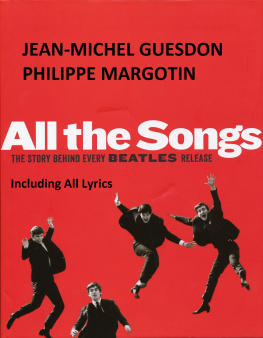

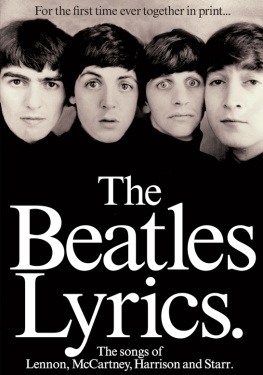
![Lambley - And the Band Begins to Play: [Part9 The Definitive Guide to the Beatles White Album]](/uploads/posts/book/213743/thumbs/lambley-and-the-band-begins-to-play-part9-the.jpg)
![Lambley - And the Band Begins to Play: [Part1 The Definitive Guide to the Beatles Please Please Me]](/uploads/posts/book/213741/thumbs/lambley-and-the-band-begins-to-play-part1-the.jpg)
